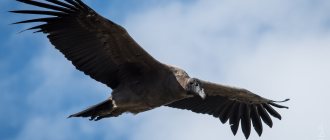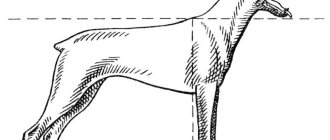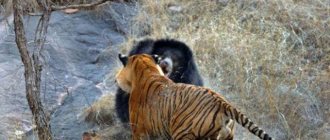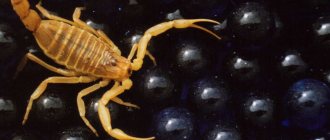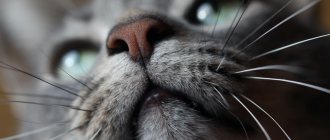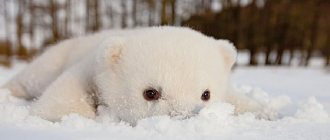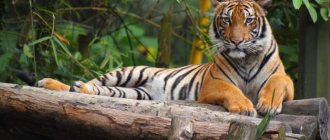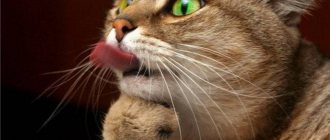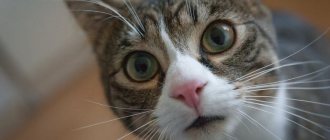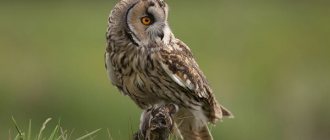As we know, there are different types of animals depending on their type of diet. The classification uses the animal kingdom, we see that there are different types depending on their habitat, development, skeletal type or how they feed. Today we will talk about predatory animals . It is important to know the nutrition of animals well because this is how we can learn how they grow, interact and move in their habitat with other living things.
In this article we will tell you about all the characteristics, nutrition and importance of carnivorous animals.
Características principales
A carnivore is an animal that feeds primarily on animal tissue. In this case we are referring to the removal of organs and bones from another animal. The word carnivore means to eat a piece of meat. . Not all carnivores eat meat exclusively, as it supplements their diet in other ways. Not all of them are animals, as we can find carnivorous plants and fungi.
These are living beings that obtain the nutrients they need to exist and develop by eating meat. By eating meat, you can hunt another animal or eat carrion. The important thing is that most of the diet consists of meat. We often forget that carnivores also feed on amphibians, insects and other invertebrates, as well as mammals, birds or fish. Not all predatory animals are represented by predators or hunters. . Many of them are scavengers, that is, they eat the remains of the decaying matter of other dead animals.
Every predatory animal plays an important role in the balance of ecosystems. Based on the type of animal in the tissue they eat, carnivores are classified into the following types:
- Avivores: They eat birds
- Hematophagous: Consume blood
- Insectivores: They eat insects
- Piscivores: They eat fish
- Eggeaters: They eat eggs
- Vermivore: They consume worms
Meerkat
Charming miniature animals from the mongoose family are incredibly charismatic and energetic. In order to keep a meerkat at home, you will not need a special enclosure or cage. The baby will calmly move around the house and sleep wherever necessary.
Meerkats can easily be trained to use a litter box, just like an ordinary cat. The animals feed on mushrooms, nuts, lean meat, milk and sour cream.
Meerkats are sociable animals. They can easily make friends with dogs and cats. But they get along best with each other, as they live in packs. Therefore, try to get two touching creatures at once, so that they definitely don’t get bored alone.
Types of predatory animals
Not all carnivores eat the same, so there are different ways to obtain nutrients. Let's see what types there are:
- Carnivores: They are perhaps the most well-known, as only species such as carnivores hunt prey that they intend to eat. Most predatory animals kill their prey. For these predators, the most logical thing to do is to be larger than their prey, although this is not entirely true. For example, lions, wolves, piranhas and ants are social predators that need to band together to kill larger animals. Subsequently, they share the prey and feed together.
- Scavengers: These are the ones that consume, that is, the dead animal. Searching for carrion also requires effort and time. For example, vultures are exclusively scavenger predators. Most carnivores are a mixture of different types of food. Some may eat carrion, but this is not the only thing they base their diet on. Most scavengers also join the hunting market and become breadwinners. That is, they will hunt their prey whenever they need to, but are available dead prey to them. These include bears, crows, lions, coyotes and lizards.
fennec
Fenechs are small charming foxes with huge funny ears and a sly expression on their faces. Many people who are thinking about keeping a wild animal at home pay attention specifically to the touching fennec foxes.
But buying such an animal is very expensive, so few can afford such luxury. And keeping such a fox is not an easy task. It is advisable to provide the animal with a separate room where sunlight does not reach it. There should also be sand in the room because these animals come from deserts and love to dig it up.
Fenech is a heat-loving animal, even minimal coolness can lead the animal to illness and death.
Taming a fennec requires patience, care and attention. If you are willing to devote enough time to your long-eared pet, in return you will receive an incredibly loyal friend.
Diet of carnivores
We can also classify different types of carnivores based on their diet. They do not have to eat only meat, they can also supplement their diet with fruits, vegetables, nectar, mushrooms and other substances. They are primarily dependent on animal tissue, although a carnivorous animal will adapt to a different type of diet depending on its environment and whether it forces it to do so.
Depending on the composition of the diet, we see different predatory animals. Let's see what they are:
- Strict Carnivores: You can say that they are true predators. Their diet consists of 100% meat or close to it. Here we have polar bear, lion, crocodile, etc.
- Hypercarnivores: Their diet consists of 70% or more meat. Here we have degrees, eagles, sharks, salmon, owls and others.
- Mesocarnivores: Their diet consists of 50-70% meat. These animals evolved different types of teeth so they could consume other types of organic matter. There are dogs, ferrets, weasels, foxes and badgers.
- Hypocrites: Their diet consists of less than 30% meat, the rest ranging from fruits and mushrooms to nectar. In these animals, their teeth serve a variety of functions, including chewing hard vegetables. They have wider and flatter molars. Most of them are considered omnivores. Here we have people going to black bears, among others.
Distribution and range
Carnivores are distributed throughout the world, although in Australia there are no indigenous terrestrial representatives of the order, except for dingoes, which were introduced to the continent by humans. Land species are naturally absent from most oceanic islands, although the coastlines are commonly visited by seals. However, humans have introduced domestic animals, as well as a number of wild species, to most of the islands. For example, a large population of common foxes now lives in Australia. The introduction of carnivores into new habitats has at times had detrimental effects on native fauna. Stoats, ferrets and weasels were introduced into New Zealand to control rabbits, which were also introduced. As a result, native bird populations were decimated by carnivores. Birds have also been targeted by mongooses, which were introduced into Hawaii and Fiji to control rodent and snake populations. In Europe, American mink released from fur farms contributed to the decline of the European mink.
Because carnivores are large and dependent on meat, there must be fewer predators in the environment than the animals they feed on. Predators have a population density of approximately 1 per 2.5 km². By comparison, omnivorous mammals average about 8 individuals per 1 km², and herbivorous rodents reach densities of up to 40,000 individuals per 1 km². Relatively low population densities make the predators vulnerable to fluctuations in prey density, habitat destruction, infectious diseases, and hunting by humans. The mobility and adaptability of some carnivores have allowed them to survive changes caused by human activity. For example, the red fox, coyote, raccoon, and striped skunk can be found in urban and suburban areas of North America. In Europe, the fox lives in most large cities.
The gray wolf and Mackensan plains wolf, as well as the brown bear, once lived across much of the Northern Hemisphere, but their ranges have declined following habitat destruction, declining prey supplies, and human persecution due to competition. In Africa and South Asia the situation is the same with tigers and lions. Numerous cats, bears and some seals have become rare and endangered.
Habitat and significance
Carnivores live in every environment on the planet. However, most of them can be found in terrestrial ecosystems. They can usually be found where predatory species live and are common in rivers, seas and oceans, and in the air for detection. at high altitudes and on land in ecosystems such as deserts, arid areas, forests, beaches, jungles, sheets , etc.
The importance of these animals is that they play a fundamental role in regulating the population size of a species in an ecosystem. That is, without the consumption of animals in the food chain, we cannot have the correct ecological balance. In this way, the carnivore helps regulate the population of species and maintains balance in nature.
We are going to give an example of a food chain where a carnivorous animal interferes. Passive predators such as spiders require their prey to penetrate the web. This also happens to filter feeders that hunt for a constant volume of water passing through their cheap filter. We are going to highlight several types of response between prey and predator population size:
- Type I : one where the predator is constant and independent of prey density. This can happen when there is not enough prey to satisfy its predators.
- Type II: The rate of predation decreases as the prey population increases. We also see an increase in predation rates from declining to peak levels.
- Type III: Predation rates are lower when prey densities are low and increase to a maximum and then decrease when predation rates peak.
I hope that with this information you can learn more about carnivorous animals and their characteristics.
Ecology DIRECTORY
Organisms that cannot build their own substance from mineral components are forced to use what is created by autotrophs by eating them. They are therefore called heterotrophs, which means “fed by others,” or consumers (from the Latin consumo - to consume). However, not all organisms can limit themselves to the consumption of plant foods to satisfy their physiological needs, building the proteins of their body directly from plant proteins. For many species, evolution has determined the need to use animal proteins with a specific set of amino acids. These are carnivorous animals. They are also consumers, but unlike herbivores, they are secondary consumers (or second order). The trophic chain may not end here, and the secondary consumer can serve as a source of food for a third-order consumer, etc. (Fig. 2.15).[...]
All organisms must consume resources in order to live and carry out their daily functions. Transfer of these resources (nutrients and the embodied energy they contain) from one organism to another, etc. forms a food chain. The main stages in the chain are called trophic levels (from the Greek word for food). The first of the traditional trophic levels in bioecology is that of primary producers (eg plants), which use energy and essential nutrients to produce materials usable at higher trophic levels (seeds, leaves, etc.). The next few trophic levels consist of herbivores, carnivores, and decomposers of organic matter (they receive residues from some other trophic levels and regenerate from them substances that can be used by primary producers). Thus, there are four types of trophic levels: (1) extractive; (2) producers, (3) consumers (often on several levels) and (4) decomposers (saprophytes). Within trophic levels, it is sometimes necessary to distinguish between guilds, which are groups of organisms that share common methods, dispersal, and foraging practices.[...]
Zoophages are carnivorous organisms that feed on animals of other or their own species (cannibalism).[...]
The rest of the organisms consume ready-made energy-bearing food: herbivores eat plants, carnivores eat herbivores, other carnivores eat these carnivores, etc. Such organisms are called heterotrophs - “eating animals” or consumers - consumers).[...]
Autotrophic organisms serve as food (a source of energy) and the initial material that ensures the existence of heterotrophic organisms. For consumers, the only source of nutrition is autotrophs (for herbivores) or other organisms (for carnivores). In the process of life, consumers also consume oxygen and release carbon dioxide. Saprophages feed on mortmass - dead organic matter, organic remains (hyenas, vultures, some crustaceans, fly larvae, etc.). Saprophytes (most fungi and microorganisms) feed on organic substances (excrement, mucus, etc.) secreted by other organisms. In general, decomposers contribute to the mineralization of organic matter, its transition to a state assimilated by producers, and are the final link in the biological cycle.[...]
Microelements enter the human body with plant and animal food, partly with water, according to the scheme: soil - plant - animal body. The level of provision of plant and animal organisms with microelements depends on their content primarily in the soil. A lack or excess of microelements in the soil leads to a deficiency or excess not only in herbivores, but also in carnivores, as well as in the human body. This entails a weakening or strengthening of the synthesis of biologically active substances, which include microelements, disruption of the process of intermediate metabolism, and the occurrence of diseases. Diseases associated with a deficiency or excess of microelements are called endemic (from the Greek epsktoe - local). Areas in which deviations in the development of plants and animals are found, and where endemic diseases associated with local geochemical features are recorded, A.P. Vinogradov called biogeochemical provinces. In the USSR, biogeochemical provinces are known that are poor in iodine (western regions of Ukraine), poor in cobalt and copper (Baltic republics, Yaroslavl region), etc. [...]
Consumers are heterotrophic organisms (mostly animals) that consume organic matter from other organisms - plants (herbivores - phytophages) and animals (carnivores - zoophages).[...]
They are followed by heterotrophic organisms, divided into first-order consumers, which eat autotrophic producers (for example, zooplankton), and second-order consumers - carnivorous animal organisms that feed on herbivorous organisms. Depending on the circumstances, a third and higher order of consumers can be identified, which include predators, parasites or organisms that feed on dead inhabitants of the biotope.[...]
Trophic level is a set of organisms that are similar in type of nutrition and occupy a certain position in the nutrition pyramid; levels are usually distinguished: I - producers (plants), II - herbivores (phytophages), III - carnivores (zoophages). [...]
Population pyramids reflect the density of organisms at each trophic level. The first pyramid was built by Charles Elton. To construct them, the number of organisms in a given territory is counted, grouped by trophic levels and presented in the form of a rectangle, the length (or area) of which is proportional to the number of organisms living in a given area (or in a given volume, if it is an aquatic ecosystem). The basic rule has been established: in any environment there are more plants than animals, more herbivores than carnivores, more insects than birds, etc. (Fig. 10).[...]
A consumer is a heterotrophic (i.e., feeding on other organisms) organism that converts the biomass of producers and other consumers into the biomass of its body (herbivores and carnivores).[...]
Parasitism is characterized by the feeding of one type of organism at the expense of the body tissues or digested food of another, called the host of the first, and the host does not immediately die as a result of the attack of the parasite. Since predation also involves the feeding of some animal species on the body tissues of others, meaning obligate parasites, Acad. E. N. Pavlovsky (1946) also emphasizes the importance of the carnivorous mode of nutrition as specific to the species, and parasites differ from predators in their repeated feeding. The specificity of nutrition distinguishes parasitism from so. called false parasitism, in which feeding at the expense of another organism is observed only rarely and accidentally. For example, larvae of the carrion fly (Lucilia caesar L.) were found on dead tissue in human wounds, and larvae of the gray blowfly (Sarcophaga carnaria L.) were found in the intestines of people. Saprophytic larvae of the flies Muscina stabulans Flln. and M. pascuorum Mgn. were discovered living parasitically on the caterpillars of the nun butterfly (Lymanthria monacha L.). These are cases of false and accidental parasitism.[...]
Based on the characteristics of the food they consume, heterotrophic organisms are divided into herbivores (phytophages), carnivores (zoophages) and carnivores (detritivores). Many types of heterotrophs have a mixed type of nutrition. According to the nature of combinations of nutritional types, heterotrophic organisms are carnivorous-herbivorous, carnivorous-herbivorous, etc. Based on the nature of the food consumed and the characteristics of combinations of nutritional types, agricultural (domestic) animals and fur-bearing animals can be divided into phytophages (horses, cattle, sheep, goats, chickens, turkeys, ducks, geese), carnivorous herbivores (pigs, dogs), carnivores (foxes, sables, minks).[...]
Plants are objects of nutrition for heterotrophic organisms—consumers. Consumers include animals, including farm animals. Most domestic mammals and birds are herbivores (herbivores). Herbivores are food sources for predators and parasites. Among farm animals, carnivores include foxes, minks, and other types of fur-bearing animals bred in fur farms. [...]
This level unites animals with a carnivorous type of nutrition (zoophages). Usually, all predators1 are considered in this group, since their specific features practically do not depend on whether the prey is a phytophage or a carnivore. But strictly speaking, only predators that feed on herbivores and, accordingly, represent the second stage of transformation of organic matter in food chains should be considered consumers of the second order. The chemical substances from which the tissues of an animal organism are built are quite homogeneous, therefore the transformation during the transition from one level of consumers to another is not as fundamental as the transformation of plant tissues into animals.[...]
Consumers are of the first order (herbivorous animals), second order (primary predators that feed on herbivores), third order (secondary predators that feed on carnivores), etc. [...]
The main producers of biomass are autotrophic organisms - plants. They are called producers. As a result of photosynthesis, solar energy is converted into bond energy and accumulated in plant biomass. Then the energy accumulated by plants passes into the energy of heterotrophic organisms (consumers) of the first (herbivores) and subsequent orders (carnivores).[...]
Zoobarriers M represent the accumulation of chemical elements by living organisms. The role of this natural barrier can be judged by the zoomass of certain species relative to the area of the landscape of their distribution. It has been established that 90-95% of terrestrial zoomass falls on the share of invertebrate organisms. The ratio of the zoomass of herbivores to the zoomass of carnivores is always close to 100, and the highest productivity of herbivores is observed in the landscapes of herbaceous formations of the tropical zone.[...]
When plants and animals die, their bodies become a resource for other organisms. Of course, in a certain sense, all consumers subsist on dead material—carnivores catch and kill their prey, and a green leaf torn off by a herbivore becomes dead as soon as digestion begins. The main difference between the organisms we will consider in this chapter and organisms such as herbivores, carnivores, and parasites is that predators and parasites directly influence the rate of production of food resources. Lions hunting gazelles, gazelles feeding on grass, and cereals affected by rust fungi - all of them, as a result of consuming a resource, disrupt its ability to reproduce itself (increase the number of gazelles or the mass of grass). At the same time, some categories of mutualists can increase the supply of resources that their partner provides to them (Chapter 13). Unlike these groups of organisms, decomposers (bacteria and fungi) and detritivores (animals that consume dead material) do not control the rate at which their resources become available or are renewed; they are completely dependent on the speed with which some other factor (aging, disease, struggle, shading of leaves by trees) releases the resource that ensures their vital activity. [...]
The second group is represented by consumers, i.e. consumers (from Latin consumo - to consume) - heterotrophic organisms, mainly animals that eat other organisms. There are primary consumers (animals that eat green plants, herbivores), and secondary consumers (predators, carnivores that eat herbivores). A secondary consumer can serve as a source of food for another predator - a third-order consumer, etc. [...]
The food absorbed by the consumer is not completely absorbed - from 12 to 20% in some herbivores, up to 75% or more in carnivores. Energy costs are associated primarily (Fig. 5.5) with the maintenance of metabolic processes, which are called respiration costs, estimated by the total amount of CO2 released by the body. A significantly smaller part goes to the formation of tissues and a certain supply of nutrients, i.e., to growth. The rest of the food is excreted as excrement. In addition, a significant part of the energy is dissipated as heat during chemical reactions in the body and, especially, during active muscular work. Ultimately, all the energy used for metabolism is converted into heat and dissipated in the environment.[...]
Part of the chemical energy accumulated by terrestrial plants is further absorbed by herbivores, and then by carnivores that eat herbivores. Remains of dead organic matter formed after the death of living organisms or during their vital activity (for example, fallen branches, leaves, etc.) are destroyed by destructors (primarily microorganisms), enter the soil, water, air at a certain speed and are reincorporated into the biotic cycle. In this case, part of the substance is excluded from the biotic cycle and, with the help of geochemical processes, is fixed in sedimentary deposits or transferred to the ocean.[...]
Trophic connections between animals and plants are of paramount importance; they can be called the relationships between autotrophic and heterotrophic organisms. Almost all organisms, with rare exceptions (some predators and parasites), feed on plant foods. However, there is a specialized group of saprophages that live off decaying organic matter (hyenas, jackals, vultures), as well as coprophages that feed on animal excrement. It should be noted that plant foods are also consumed by typical carnivores, albeit at certain periods of life. Thus, sable and marten eat berries and plant seeds when they cannot obtain animal food for themselves. It is almost impossible to find species among animals that do not feed on plant foods at all.[...]
Currently, as a result of intoxication with organochlorine preparations, the number of birds, especially raptors, has greatly decreased. Insecticides are very dangerous for carnivores, since they gradually concentrate in living organisms as they move towards the final links of food chains. Here insecticides act as cumulative poisons. [...]
Food chains begin with phytoplankton, which can be called the “grazing land of the sea.” The next link in the food chain is the phytoplankton-eating zooplankton, both carnivorous and mixed. Consumers of phyto- and zooplankton can be very different; these include many marine invertebrates and many fish. Food chains end with mammals, which includes humans. It would be more correct to talk about this system not as several chains, but as a wide network with many branches. With each new link in the chain, there is an increase in the concentration of harmful substances in the body - large consumers enrich themselves with them, eating a lot of lower, smaller ones. These harmful substances accumulate primarily in the liver, as well as in lipid-rich tissues. [...]
The largest amounts of bound nitrogen are found in coal (1 - 2.5%) and oil (0.02 - 1.5%), as well as in the waters of rivers, seas and oceans. Nitrogen accumulates in soils (0.1%) and in living organisms (0.3%). Although nitrogen means “non-life-sustaining,” it is actually an essential element for organisms to function. Animal and human protein contains 16 - 17% nitrogen. In the organisms of carnivorous animals, protein is formed due to the consumed protein substances present in the organisms of herbivorous animals and in plants. Plants synthesize protein by assimilating nitrogenous substances contained in the soil, mainly inorganic. Significant amounts of nitrogen enter the soil thanks to nitrogen-fixing microorganisms, which convert free nitrogen from the air into nitrogen compounds. [...]
Food chains and trophic levels. By tracing the food relationships between members of the biocenosis (“who eats whom and how much”), it is possible to build food chains for various organisms. An example of a long food chain is the sequence of inhabitants of the Arctic sea: “microalgae (phytoplankton) -> small herbivorous crustaceans (zooplankton) - carnivorous planktivores (worms, crustaceans, mollusks, echinoderms) -> fish (2-3 links in the sequence of predatory fish are possible) - > seals -> polar bear.” Terrestrial ecosystem chains are usually shorter. A food chain, as a rule, is artificially isolated from a really existing food web - a network of many food chains. [...]
The flow of solar energy is perceived by the molecules of living cells and converted into the energy of chemical bonds. The chemical substances created in this way (during photosynthesis) successively pass from one organism to another: from plants to herbivorous animals (hare), from them to carnivores of the first order (fox), then of the second order (wolf) and so on. This transition is considered as a sequential ordered flow of matter and energy.[...]
According to calculations, at each stage of the transfer of matter and energy through the food chain, approximately 90% of the energy is lost and only about one tenth of it passes to the next consumer. The specified ratio in the transfer of energy in the food connections of organisms is called the “ten percent rule” (Lindeman’s principle). For example, the amount of energy that reaches tertiary carnivores (fifth trophic level) is only about 10-4 of the energy absorbed by producers. This explains the limited number (5-6) links (levels) in the food chain, regardless of the complexity of the species composition of the biocenosis.[...]
The primary consumers—consumers of organic matter—are animals. They receive their main energy supply by eating plants. This is how the general food chain, or food chain, begins. Predators consume the tissues of herbivores and weaker carnivores. Parasites exist at the expense of other organisms, they are used by superparasites, the food chain ends with decomposer microorganisms that return organic matter to a mineral state, while the energy flow gradually dries up. [...]
Life on Earth exists due to solar energy. Light is the only food resource on Earth, the energy of which, in combination with carbon dioxide and water, gives rise to the process of photosynthesis. Photosynthetic plants create organic matter that herbivores feed on, carnivores feed on, etc., ultimately, plants “feed” the rest of the living world, i.e., solar energy is, as it were, transmitted through plants to all organisms.[...]
The location of each link in the food chain is called a trophic level. The first trophic level is always producers, plants, creators of organic matter, biomass; the second trophic level consists of herbivores - consumers or consumers of the 1st order; consumers of herbivores - carnivores - make up the next trophic level, are consumers of the 2nd order; consumers of carnivorous forms belong to consumers of the 3rd order, etc. along the trophic chain. In this case, the food specialization of consumer organisms is important. Species with a wide range of diets can be included in the food chain at different trophic levels. For example, a person whose diet includes both plant and animal foods can appear in different food chains as a consumer of the first, second and third orders.[...]
In animals of different species and breeds, the chemical composition of the body changes differently: for example, the body of a newborn rabbit, compared to the body of a newborn calf, is richer in water, but much poorer in protein and ash. This may serve as an indirect indicator of the differences in animal growth patterns noted above: rabbits, like carnivores, are born at an earlier stage of development and their body chemistry at birth is closer to that of a 6-month cattle embryo. And in the future, the chemical composition of the body in different animals changes with unequal intensity. Thus, the fat content in the body of a growing calf increases much faster and reaches a much higher maximum, and the protein content, on the contrary, grows more slowly and reaches a lower maximum than in a growing rabbit. With age, the proportion of nuclear mass and nucleoprotent phosphorus in the animal body sharply decreases (Table 18).[...]
We know almost nothing about the geographic variability of the chemistry of animal feed and the influence on it of specific environmental conditions of the population, but a difference of this kind must certainly exist. It is known that in fish-eating ducks and in fish-fed pigs, the fat deposits have a strong smell of fish. Biochemistry has established that in the fat depots of the body, when feeding on animal food, the fat of the eaten animal is deposited with all its characteristic qualitative indicators, i.e., the substances contained in the body of the animals that served as food, with their qualitative relationships between individual components, are used to build it. elements. Through them, the organisms of carnivorous animals perceive the impact of the biochemistry of the habitat - the geochemical landscape as a whole. [...]
The cutting off by the supersystem and intersystem relations of many probable paths of development of subsystems, the determinism of their development, presupposes the presence of a single channel of change, their simultaneity and conjugacy. Biologists of the first third of the last century drew attention to this. In 1830, J. Cuvier formulated the law of anatomical (or structural) correlation. Its modern meaning: in the body, as an integral system, all its parts correspond to each other both in structure (the law of subordination of organs) and in function (the law of subordination of functions). A change in one part of the body or a separate function inevitably entails a change in other parts and functions. Horns correspond to hooves, not carnivorous teeth, herbivory, not carnivory. But in any system there is a coordination of parts, otherwise it would go astray, there would be no unity. Obviously, the law of coordination of the structure and rhythm (functions) of parts (subsystems), or the law of synchronization and harmonization of system components, operates: in a system as a self-organizing unity, the individual characteristics of subsystems are coordinated with each other. One of the most important consequences of this law is that the loss of one of the links in the system changes the structure and functions of others associated with this law, or completely changes the whole. The loss of an atom from a molecule makes the molecule completely different; an evolutionary change in one of the functional organs changes the entire structure of the organism, etc. [...]
It is obvious that the links (and the organisms included in them) forming the food, or trophic, chain are unequal, primarily from the point of view of the space they occupy. Therefore, in ecology it is customary to talk not just about chain links, but about certain trophic levels. At the first level, obviously, there are green plants - producers; the next trophic level consists of herbivorous organisms; they are followed by representatives of a higher level - carnivores, which, in turn, serve as a source of food for the next level - second-order carnivores. Then the chain discussed above can be written as follows: “oak - gypsy moth - parasite - secondary parasite.” [...]
The amount of energy spent on maintaining one’s own vital functions in the chain of trophic levels increases, and productivity decreases. The energy balance of consumers is as follows. Absorbed food is usually not completely absorbed. Undigested food is returned to the external environment in the form of excrement and can subsequently be involved in other food chains. The percentage of digestibility depends on the composition of the food and the set of digestive enzymes in the body. In animals, digestibility varies from 12 - 20% (some saprophages) to 75% in carnivorous species. [...]
The relationships between the inhabitants of tropical rainforests based on the type of food they eat are very complex. In Fig. Figure 70 shows a diagram of the relationship of trophic chains in the tropical rainforest ecosystem of South America. The shaded sectors represent the contribution of each type of nutrition to the creation of total animal biomass. The inner ring includes purely herbivorous forms of consumers of the first order, feeding both on dead parts of plants (1-4 - termites, beetles, bark beetles) and living plants (5-16 - two-toed sloth, parrots, howler monkey, butterflies , cicadas, tapir, etc.). The middle ring covers omnivores, i.e. consumers of the first and higher orders (17-24 - capuchin monkey, raccoon, hummingbirds, wasps, ants, mouse-like opossum). The outer ring contains carnivorous forms, i.e. consumers of the second and higher orders: 25-46 (mantis, iguana, anteater, woodpecker, boa constrictor, jaguar, armadillo, scorpion, etc.); This also includes animals living underground (ticks, cockroaches, dung beetles, earthworms). The royal vulture (44) and blood-sucking mosquitoes (46) - scavengers and parasites - are representatives of consumers of the highest order. Despite the endless variety of plant and animal species in the humid tropics, everything is quite orderly here, with each organism occupying its own ecological niche.[...]
We have seen that each plant requires 20-30 separate resources to complete its life cycle, and that most plants require the same set of resources (though, of course, in slightly different proportions). Each of the resources has to be extracted independently of the others, and often in its own, very special way: one in the form of ions (K+), and the other in the form of molecules (CO2), one in a dissolved state, the other in a gaseous state. Carbon cannot be replaced with nitrogen, and phosphorus cannot be replaced with potassium. Only very few of the resources needed by higher plants can be replaced in whole or in part. Most plants are able to absorb nitrogen in both nitrate and ammonium forms (i.e., as part of the corresponding ions), but there is nothing to replace nitrogen itself. Studying the food resources of carnivores, we find a completely opposite picture: almost any prey they eat can be successfully replaced by almost any other prey of approximately the same size. Thus, resources, each of which is irreplaceable for the body, are opposed to interchangeable resources. Based on this contrast, we can build a classification of jointly (in pairs) consumed resources (Fig. 3.25).[...]
Adult trematodes, being in places of localization - the bile ducts and, less often, in the pancreas of the definitive hosts, produce eggs, which are excreted with feces. In the external environment, the eggs are dispersed and ingested by mollusks. In their intestines, the miracidium hatches from the egg, migrates to the liver and turns into a sporocyst. The development period from egg to metacercaria is 2.5 months. From the duodenum of the definitive hosts, the parasites penetrate through the ducts into the liver and pancreas. Opisthorchises in the body of the definitive host reach sexual maturity after 21-28 days. The lifespan of a helminth in carnivorous animals is more than 3 years, in the human body - 10-20 years.[...]
Fox
It is best to get a fox if you live in your own house and are ready to build a spacious enclosure in your yard according to all the rules. The main thing is that the cunning red-haired thief does not dig into it and runs away to freedom.
It is not recommended to keep foxes in an apartment, again due to constant digging and the specific smell of fur.
Foxes need careful care; the animal cannot be left unattended for long. You will have to play and walk a lot with the fox.
But it won’t be possible to teach her to relieve her natural needs while walking alone. Despite all your efforts, don’t expect devotion and gratitude either - a fox’s character is not at all like a dog.
Hedgehog
Taking a hedgehog into your home straight from the forest is, of course, free and quite simple. But doing this is strongly not recommended. It is almost impossible to tame adult wild hedgehogs.
It is best to contact African hedgehog breeders. They are home to animals that live side by side with humans for generations. Therefore, it will be much easier to tame an African hedgehog.
A small animal will give you a lot of positive emotions if you are ready to surround it with proper care and attention in return. Hedgehogs are unpretentious when it comes to food, but properly arranging a cage, cleaning it and monitoring the hedgehog’s health is a more labor-intensive and responsible task.
Capybara
The capybara is an amazing animal. It’s not for nothing that the Internet is replete with photographs in which a cheerful capybara sits quite friendly next to cats, dogs, monkeys and even crocodiles.
Surprisingly, even the most dangerous animal predators never touch the capybara. All animals are irresistibly drawn to communicate with this creature. This giant rodent has won the love of the whole world.
The few capybara owners always report with delight how tame and affectionate these animals are. Despite its formidable appearance, this wonderful creature does not pose any danger to humans and can become a faithful and kind friend.
Raccoon
Having a raccoon in your apartment is truly adventurous, but fun and adventurous. Raccoons are incredibly curious, so in rooms with sockets, electrical appliances and water, the animal should always be under your close supervision.
It is recommended to allocate a separate safe room or a spacious enclosure for the raccoon, where food, plenty of water and various toys will always be available.
Raccoons are social animals; they are great friends with cats and dogs. It is better to get a hooligan animal “in a mask” from its infancy, so that the raccoon has time to get used to you, master the litter box and become as domesticated as possible.
But it will not be possible to make a raccoon completely tame - these animals are too curious and freedom-loving.
Ferret
The fashion of having ferrets at home began in Russia recently; it is only about 10 years old. In Europe, ferrets became popular as pets quite a long time ago, almost half a century ago.
Ferrets are very inquisitive, quick-witted and intelligent animals. They get along well with dogs, but a ferret may have a conflict with a cat. You should not have a ferret in a house where there are small children. Because of its curiosity, the animal can get into an unpleasant situation and, for example, bite a child or scratch him painfully.
Ferrets love to play, so be prepared to provide plenty of toys and free time.
